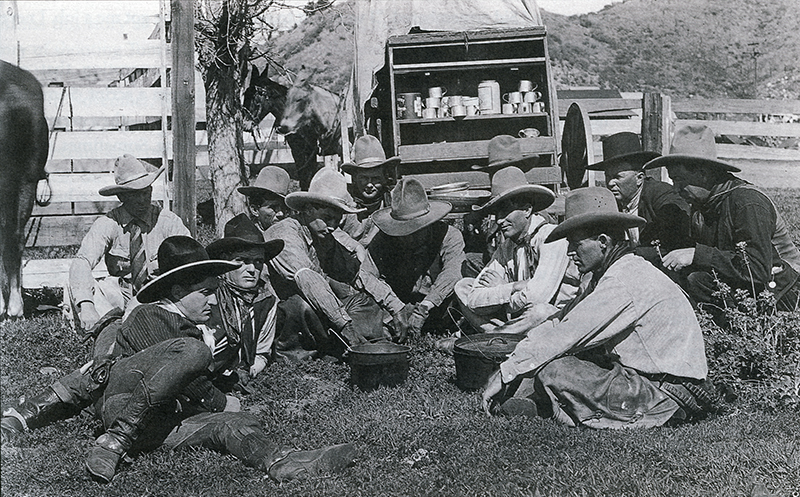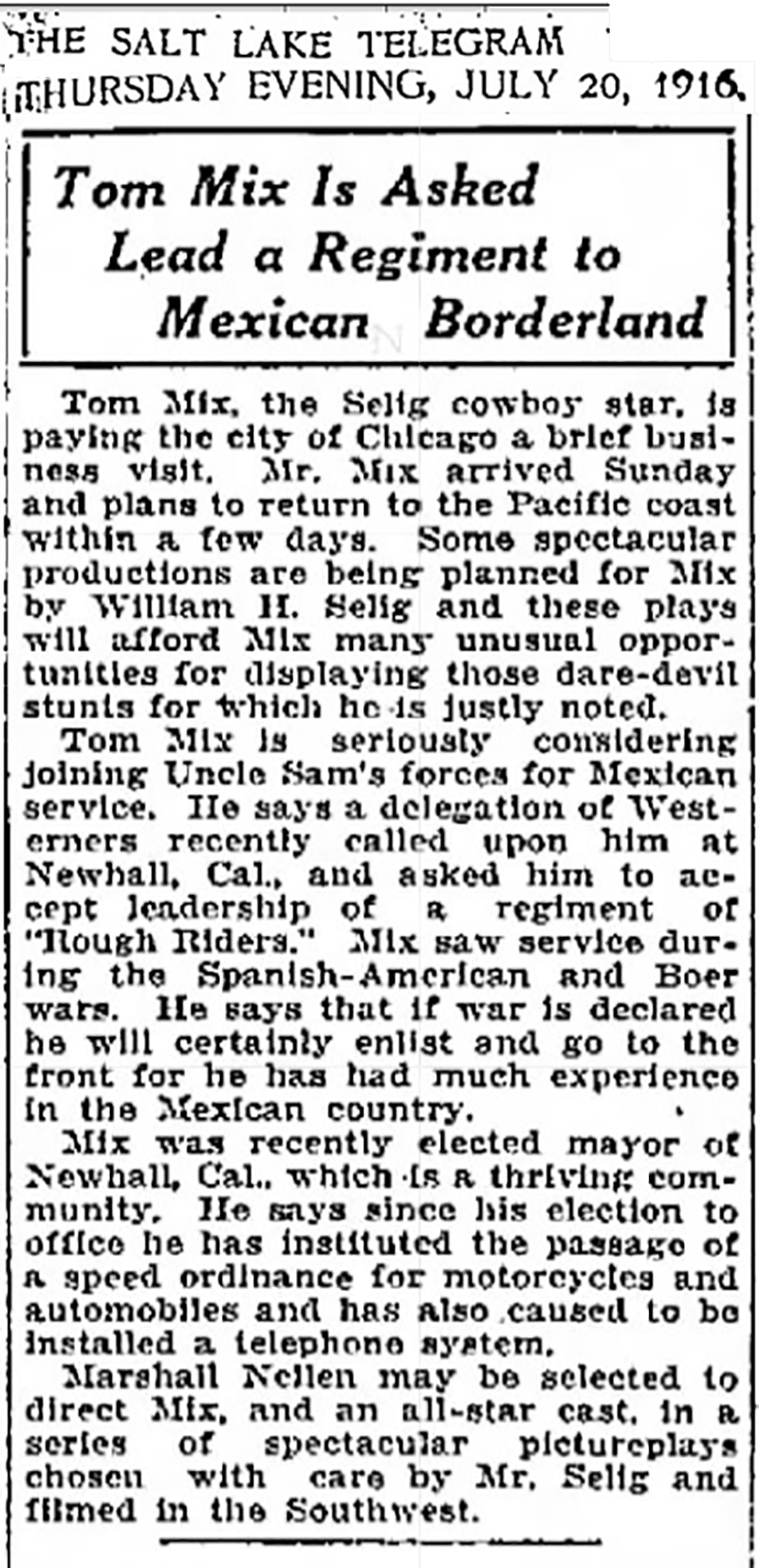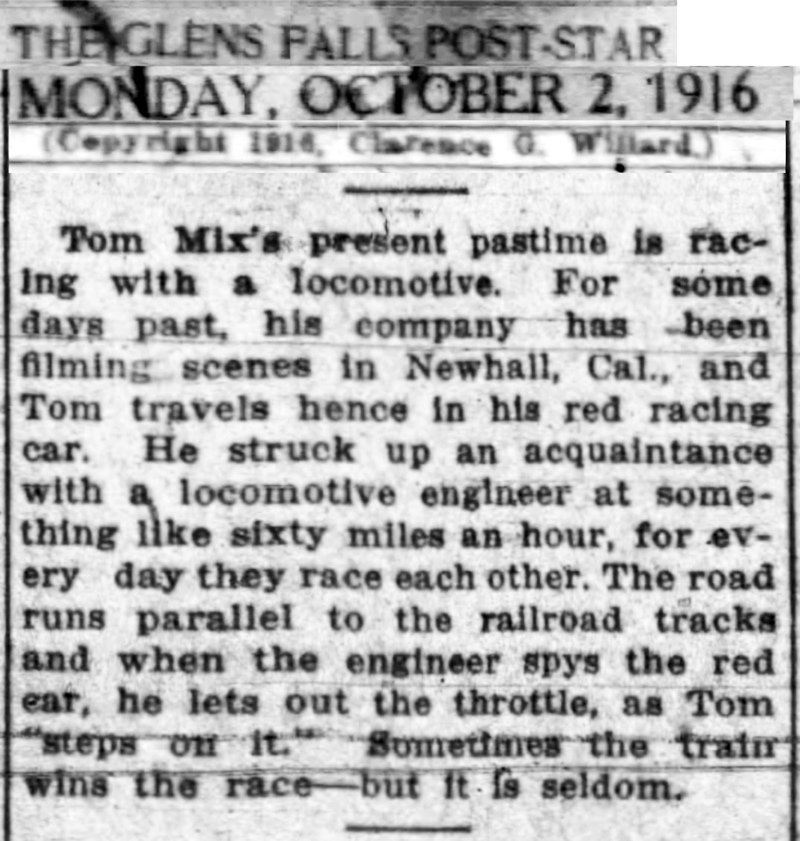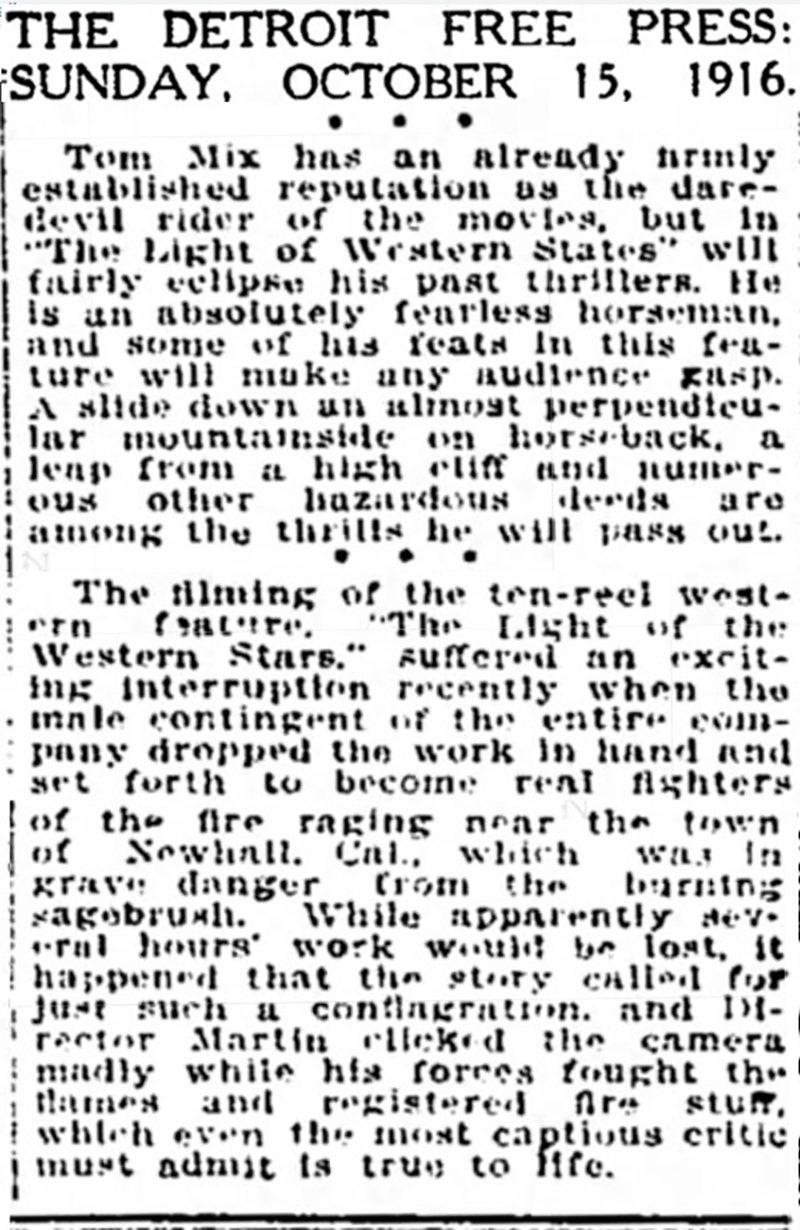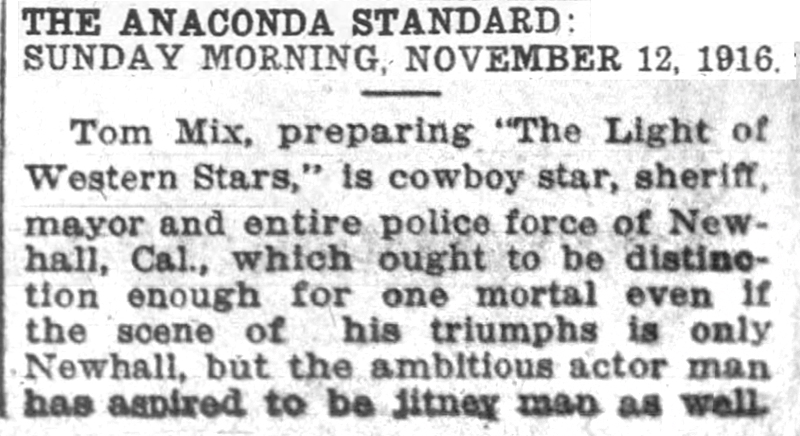|
|

Tom Mix and Selig Polyscope Crew Come to Newhall, 1916.
News Reports, 1916.
|
Photo: Tom Mix (left foreground) and crew in Newhall, 1916, probably at or near the current Veterans Historical Plaza. As published in Birchard 1993:15. * * * Actor-director-producer Tom Mix and his Selig Polyscope production crew relocated their operation from Las Vegas, N.M., to Newhall-Santa Clarita Valley in 1916. They erected a small Western movie town on the south side of Market Street between Newhall Avenue and today's Main Street. After Mix signed with William Fox in 1917 most filmmaking was done at the Fox (formerly Selig) lot at Edendale (Echo Park-Silver Lake) near Glendale, where Mix lived, although he continued to use Newhall occasionally through the mid-1920s. Surviving into the 21st Century are two bungalows at today's 24247 Main Street that were built in 1920 (per County Assessor records, which can be a little off in the 1910s-20s.) There is no evidence to suggest Mix ever set foot in Newhall prior to 1916. His movements are well documented by, among others, Mix biographer Robert S. Birchard (Birchard 1993). The film industry would eventually settle in Southern California but was still in transition in 1909-1910 when Mix started working in pictures in Missouri, Oklahoma, Florida and elsewhere around the country. He spent 1913 filming in Prescott, Ariz.; most of 1914 at Edendale; 1915 in Arizona again; and the first half of 1916 in Las Vegas, N.M. Along the way he drifted apart from his third wife, Olive, who spent most of the time at home in Oklahoma and later Glendale (Calif.), raising their daughter, Ruth. Mix took up with his leading lady, Victoria Forde, who would become his fourth wife in 1918. Birchard writes (pg. 19): "Sometime after June 1916, Tom Mix and his company came back to California. Rather than working at either of the Selig studios or his old Glendale facility, Mix moved the unit to Newhall, north of Los Angeles, in an effort to escape the jealous rampages of Olive Mix." The media run-up to Mix's move to Newhall (below) paints an entirely different picture of the star's relationship to his newly adopted movie town. Small-town newspapers loved to run syndicated Hollywood gossip columns, and Hollywood gossip columnists loved to dine on morsels fed to them by publicists — the juicier, the better. It was their stock in trade. Facts never stood in the way of legend. They couldn't. Legend was the "it" that spelled the difference between "fine actor" and star. William S. Hart was a fine actor. Yes, he eventually hired a publicist, but his reality was of his own making. Newspapers reported on facts from his real life: his public appearances and, later, his bitter court battles with his ex-wife and the studio bosses. In contrast, Tom Mix's press was carefully plotted by publicists with fertile imaginations and a Rolodex (or equivalent) full of gossip columnists. If they wanted the public to believe Mix personally jumped over Beale's Cut on his Wonder Horse Tony in 1923's "Three Jumps Ahead," then that is what got reported. By the time of Mix's arrival in Newhall in 1916, the "fake news" mongers were already out of control. They'd have us believe that sometime prior to or during 1916, Mix was elected mayor of Newhall (Newhall didn't have a mayor); that he served as town sheriff (he didn't); he created a telephone system (Newhall had 2 to 3 telephones from 1912-1916 and 5 in 1917); and he even established the town's first traffic laws. The latter is particularly absurd considering, first, that Mix was arrested and fined $50 for recklessly driving through Newhall in 1920; and, second, the manner of his death 20 years later. The upshot for historians: If Tom Mix is quoted as saying it, there is a good chance it's not true.
|
Arrives in Newhall, 1916: News Reports
(Tom Mix Mayor??)
Newhall Mixville
Newhall Mixville?
Mix in Newhall: Birchard Story 1971
Tom & Tony 1919
Reckless Driving, Newhall 1920
On Location in Newhall 1922
Studio Cottage
Tom Mix & Tony
The Man Within 1916
Western Blood 1918
Fighting for Gold 1919
Prairie Trails 1920
Clip: Wertz/Placerita House Torched for "Trailin'" 1921
3 Jumps Ahead Lobby Cards x3
3 Jumps Ahead 1923
3 Jumps Ahead 1923
Ads for 3 Jumps Ahead 1923
Mix Says He Jumped Beale's Cut 1923
1923 Letter: 3 Jumps Ahead
Mile-A-Minute Romeo 1923
The Rainbow Trail 1925
Arcade Card
Grauman's Chinese Theatre 12-12-1927
King Cowboy 1928
Pays Back Taxes 1930
Final Ride 1940-1990
No. 1 - Jan 1948
No. 8 - Aug 1948
Modern Portrait
|
The site owner makes no assertions as to ownership of any original copyrights to digitized images. However, these images are intended for Personal or Research use only. Any other kind of use, including but not limited to commercial or scholarly publication in any medium or format, public exhibition, or use online or in a web site, may be subject to additional restrictions including but not limited to the copyrights held by parties other than the site owner. USERS ARE SOLELY RESPONSIBLE for determining the existence of such rights and for obtaining any permissions and/or paying associated fees necessary for the proposed use.
